Prufrock Coffee Case Study: Talent Management Challenges & Growth
VerifiedAdded on 2023/06/17
|15
|3433
|368
Case Study
AI Summary
This case study investigates the talent management challenges faced by Prufrock Coffee, a small cafe in London, and their impact on organizational growth and performance. It evaluates the role of talent management, identifies strategies to overcome related issues, and assesses the overall impact on the company's success. The research employs a qualitative approach, utilizing both primary data collected through employee surveys and secondary data from literature reviews. Key findings reveal that Prufrock Coffee struggles with employee retention due to factors such as limited growth opportunities, ineffective leadership, and outdated recruitment processes. The study suggests improvements in work culture, recruitment policies, and leadership styles to enhance talent retention and ultimately drive organizational growth and improve customer satisfaction.

Unit 11- Questions
1
1
Paraphrase This Document
Need a fresh take? Get an instant paraphrase of this document with our AI Paraphraser
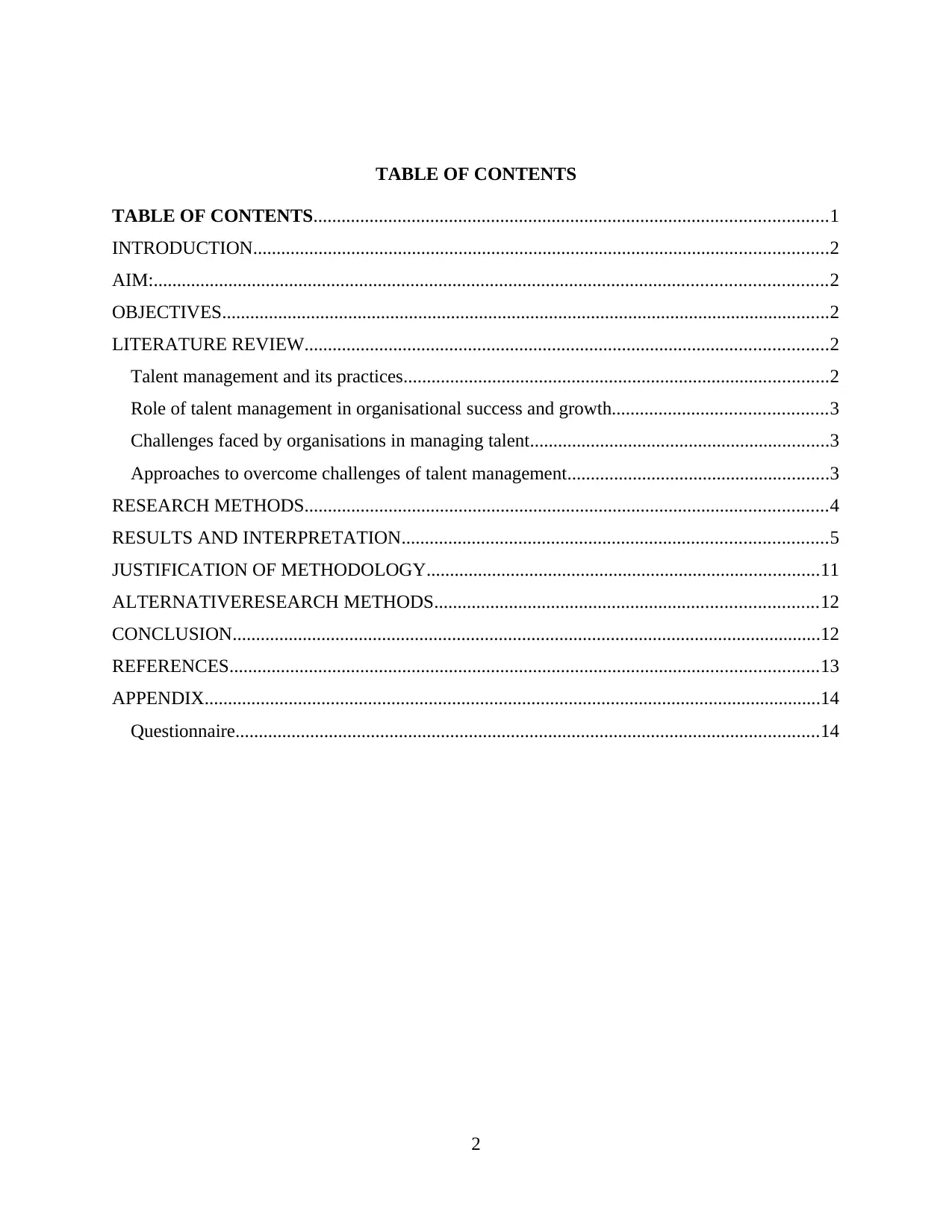
TABLE OF CONTENTS
TABLE OF CONTENTS..............................................................................................................1
INTRODUCTION...........................................................................................................................2
AIM:................................................................................................................................................2
OBJECTIVES..................................................................................................................................2
LITERATURE REVIEW................................................................................................................2
Talent management and its practices...........................................................................................2
Role of talent management in organisational success and growth..............................................3
Challenges faced by organisations in managing talent................................................................3
Approaches to overcome challenges of talent management........................................................3
RESEARCH METHODS................................................................................................................4
RESULTS AND INTERPRETATION...........................................................................................5
JUSTIFICATION OF METHODOLOGY....................................................................................11
ALTERNATIVERESEARCH METHODS..................................................................................12
CONCLUSION..............................................................................................................................12
REFERENCES..............................................................................................................................13
APPENDIX....................................................................................................................................14
Questionnaire.............................................................................................................................14
2
TABLE OF CONTENTS..............................................................................................................1
INTRODUCTION...........................................................................................................................2
AIM:................................................................................................................................................2
OBJECTIVES..................................................................................................................................2
LITERATURE REVIEW................................................................................................................2
Talent management and its practices...........................................................................................2
Role of talent management in organisational success and growth..............................................3
Challenges faced by organisations in managing talent................................................................3
Approaches to overcome challenges of talent management........................................................3
RESEARCH METHODS................................................................................................................4
RESULTS AND INTERPRETATION...........................................................................................5
JUSTIFICATION OF METHODOLOGY....................................................................................11
ALTERNATIVERESEARCH METHODS..................................................................................12
CONCLUSION..............................................................................................................................12
REFERENCES..............................................................................................................................13
APPENDIX....................................................................................................................................14
Questionnaire.............................................................................................................................14
2
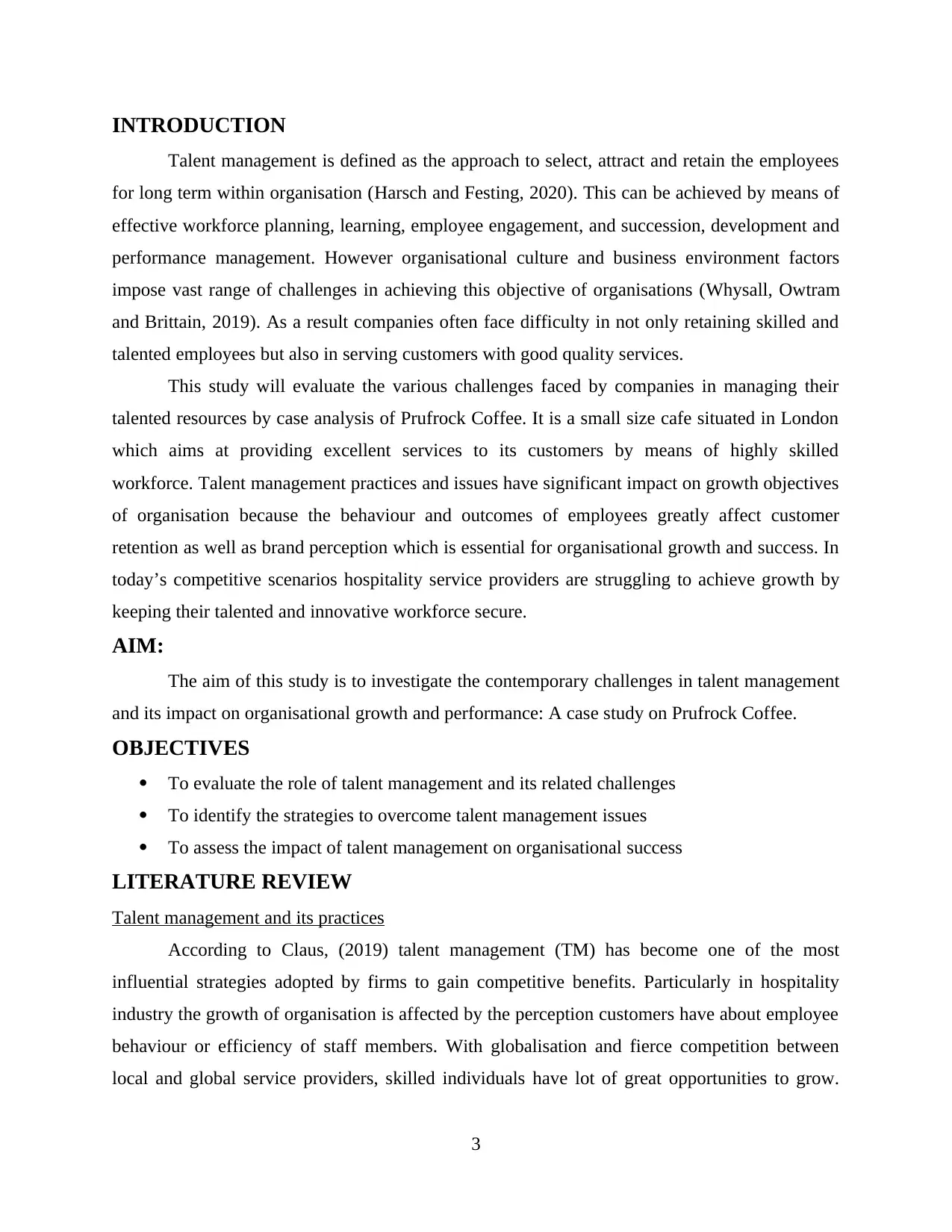
INTRODUCTION
Talent management is defined as the approach to select, attract and retain the employees
for long term within organisation (Harsch and Festing, 2020). This can be achieved by means of
effective workforce planning, learning, employee engagement, and succession, development and
performance management. However organisational culture and business environment factors
impose vast range of challenges in achieving this objective of organisations (Whysall, Owtram
and Brittain, 2019). As a result companies often face difficulty in not only retaining skilled and
talented employees but also in serving customers with good quality services.
This study will evaluate the various challenges faced by companies in managing their
talented resources by case analysis of Prufrock Coffee. It is a small size cafe situated in London
which aims at providing excellent services to its customers by means of highly skilled
workforce. Talent management practices and issues have significant impact on growth objectives
of organisation because the behaviour and outcomes of employees greatly affect customer
retention as well as brand perception which is essential for organisational growth and success. In
today’s competitive scenarios hospitality service providers are struggling to achieve growth by
keeping their talented and innovative workforce secure.
AIM:
The aim of this study is to investigate the contemporary challenges in talent management
and its impact on organisational growth and performance: A case study on Prufrock Coffee.
OBJECTIVES
To evaluate the role of talent management and its related challenges
To identify the strategies to overcome talent management issues
To assess the impact of talent management on organisational success
LITERATURE REVIEW
Talent management and its practices
According to Claus, (2019) talent management (TM) has become one of the most
influential strategies adopted by firms to gain competitive benefits. Particularly in hospitality
industry the growth of organisation is affected by the perception customers have about employee
behaviour or efficiency of staff members. With globalisation and fierce competition between
local and global service providers, skilled individuals have lot of great opportunities to grow.
3
Talent management is defined as the approach to select, attract and retain the employees
for long term within organisation (Harsch and Festing, 2020). This can be achieved by means of
effective workforce planning, learning, employee engagement, and succession, development and
performance management. However organisational culture and business environment factors
impose vast range of challenges in achieving this objective of organisations (Whysall, Owtram
and Brittain, 2019). As a result companies often face difficulty in not only retaining skilled and
talented employees but also in serving customers with good quality services.
This study will evaluate the various challenges faced by companies in managing their
talented resources by case analysis of Prufrock Coffee. It is a small size cafe situated in London
which aims at providing excellent services to its customers by means of highly skilled
workforce. Talent management practices and issues have significant impact on growth objectives
of organisation because the behaviour and outcomes of employees greatly affect customer
retention as well as brand perception which is essential for organisational growth and success. In
today’s competitive scenarios hospitality service providers are struggling to achieve growth by
keeping their talented and innovative workforce secure.
AIM:
The aim of this study is to investigate the contemporary challenges in talent management
and its impact on organisational growth and performance: A case study on Prufrock Coffee.
OBJECTIVES
To evaluate the role of talent management and its related challenges
To identify the strategies to overcome talent management issues
To assess the impact of talent management on organisational success
LITERATURE REVIEW
Talent management and its practices
According to Claus, (2019) talent management (TM) has become one of the most
influential strategies adopted by firms to gain competitive benefits. Particularly in hospitality
industry the growth of organisation is affected by the perception customers have about employee
behaviour or efficiency of staff members. With globalisation and fierce competition between
local and global service providers, skilled individuals have lot of great opportunities to grow.
3
⊘ This is a preview!⊘
Do you want full access?
Subscribe today to unlock all pages.

Trusted by 1+ million students worldwide
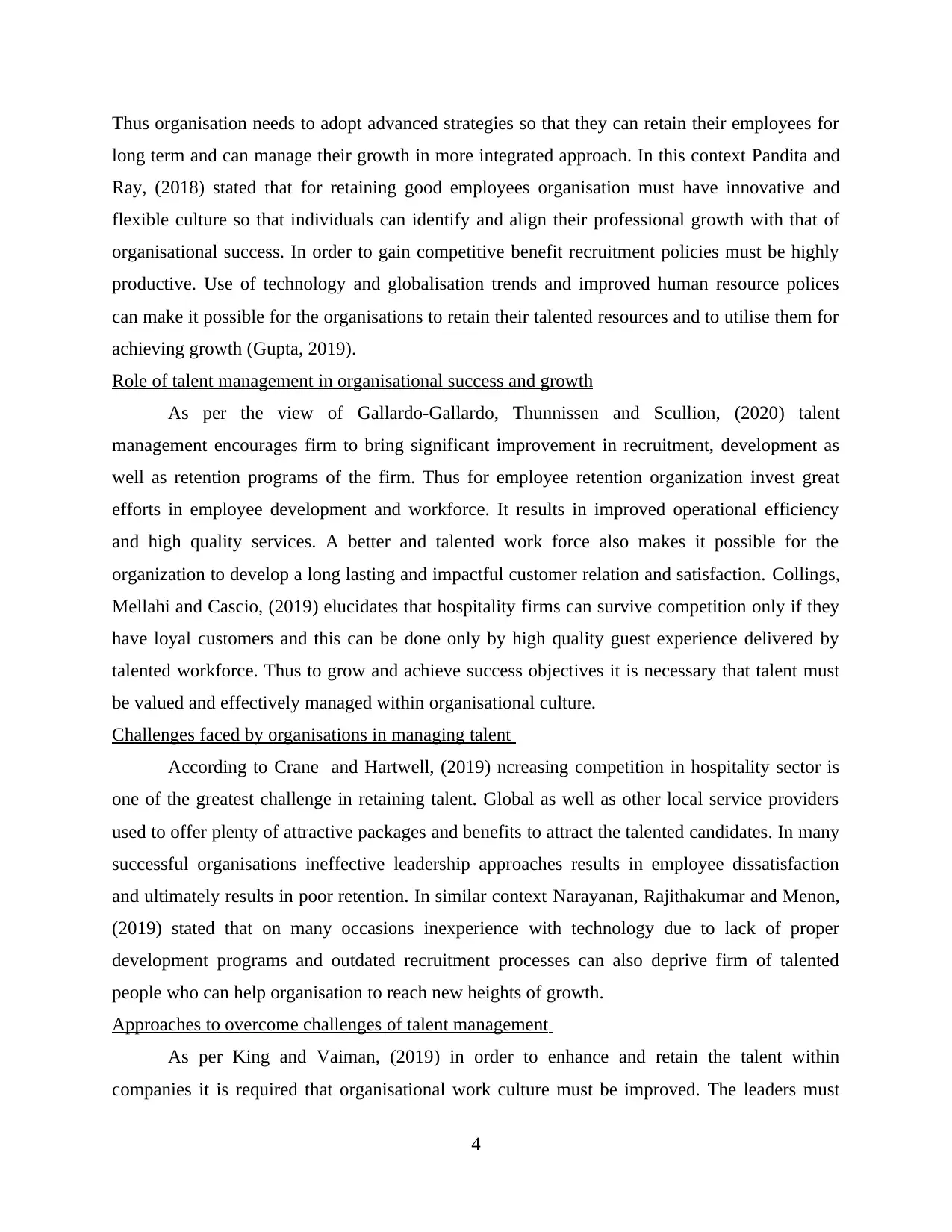
Thus organisation needs to adopt advanced strategies so that they can retain their employees for
long term and can manage their growth in more integrated approach. In this context Pandita and
Ray, (2018) stated that for retaining good employees organisation must have innovative and
flexible culture so that individuals can identify and align their professional growth with that of
organisational success. In order to gain competitive benefit recruitment policies must be highly
productive. Use of technology and globalisation trends and improved human resource polices
can make it possible for the organisations to retain their talented resources and to utilise them for
achieving growth (Gupta, 2019).
Role of talent management in organisational success and growth
As per the view of Gallardo-Gallardo, Thunnissen and Scullion, (2020) talent
management encourages firm to bring significant improvement in recruitment, development as
well as retention programs of the firm. Thus for employee retention organization invest great
efforts in employee development and workforce. It results in improved operational efficiency
and high quality services. A better and talented work force also makes it possible for the
organization to develop a long lasting and impactful customer relation and satisfaction. Collings,
Mellahi and Cascio, (2019) elucidates that hospitality firms can survive competition only if they
have loyal customers and this can be done only by high quality guest experience delivered by
talented workforce. Thus to grow and achieve success objectives it is necessary that talent must
be valued and effectively managed within organisational culture.
Challenges faced by organisations in managing talent
According to Crane and Hartwell, (2019) ncreasing competition in hospitality sector is
one of the greatest challenge in retaining talent. Global as well as other local service providers
used to offer plenty of attractive packages and benefits to attract the talented candidates. In many
successful organisations ineffective leadership approaches results in employee dissatisfaction
and ultimately results in poor retention. In similar context Narayanan, Rajithakumar and Menon,
(2019) stated that on many occasions inexperience with technology due to lack of proper
development programs and outdated recruitment processes can also deprive firm of talented
people who can help organisation to reach new heights of growth.
Approaches to overcome challenges of talent management
As per King and Vaiman, (2019) in order to enhance and retain the talent within
companies it is required that organisational work culture must be improved. The leaders must
4
long term and can manage their growth in more integrated approach. In this context Pandita and
Ray, (2018) stated that for retaining good employees organisation must have innovative and
flexible culture so that individuals can identify and align their professional growth with that of
organisational success. In order to gain competitive benefit recruitment policies must be highly
productive. Use of technology and globalisation trends and improved human resource polices
can make it possible for the organisations to retain their talented resources and to utilise them for
achieving growth (Gupta, 2019).
Role of talent management in organisational success and growth
As per the view of Gallardo-Gallardo, Thunnissen and Scullion, (2020) talent
management encourages firm to bring significant improvement in recruitment, development as
well as retention programs of the firm. Thus for employee retention organization invest great
efforts in employee development and workforce. It results in improved operational efficiency
and high quality services. A better and talented work force also makes it possible for the
organization to develop a long lasting and impactful customer relation and satisfaction. Collings,
Mellahi and Cascio, (2019) elucidates that hospitality firms can survive competition only if they
have loyal customers and this can be done only by high quality guest experience delivered by
talented workforce. Thus to grow and achieve success objectives it is necessary that talent must
be valued and effectively managed within organisational culture.
Challenges faced by organisations in managing talent
According to Crane and Hartwell, (2019) ncreasing competition in hospitality sector is
one of the greatest challenge in retaining talent. Global as well as other local service providers
used to offer plenty of attractive packages and benefits to attract the talented candidates. In many
successful organisations ineffective leadership approaches results in employee dissatisfaction
and ultimately results in poor retention. In similar context Narayanan, Rajithakumar and Menon,
(2019) stated that on many occasions inexperience with technology due to lack of proper
development programs and outdated recruitment processes can also deprive firm of talented
people who can help organisation to reach new heights of growth.
Approaches to overcome challenges of talent management
As per King and Vaiman, (2019) in order to enhance and retain the talent within
companies it is required that organisational work culture must be improved. The leaders must
4
Paraphrase This Document
Need a fresh take? Get an instant paraphrase of this document with our AI Paraphraser
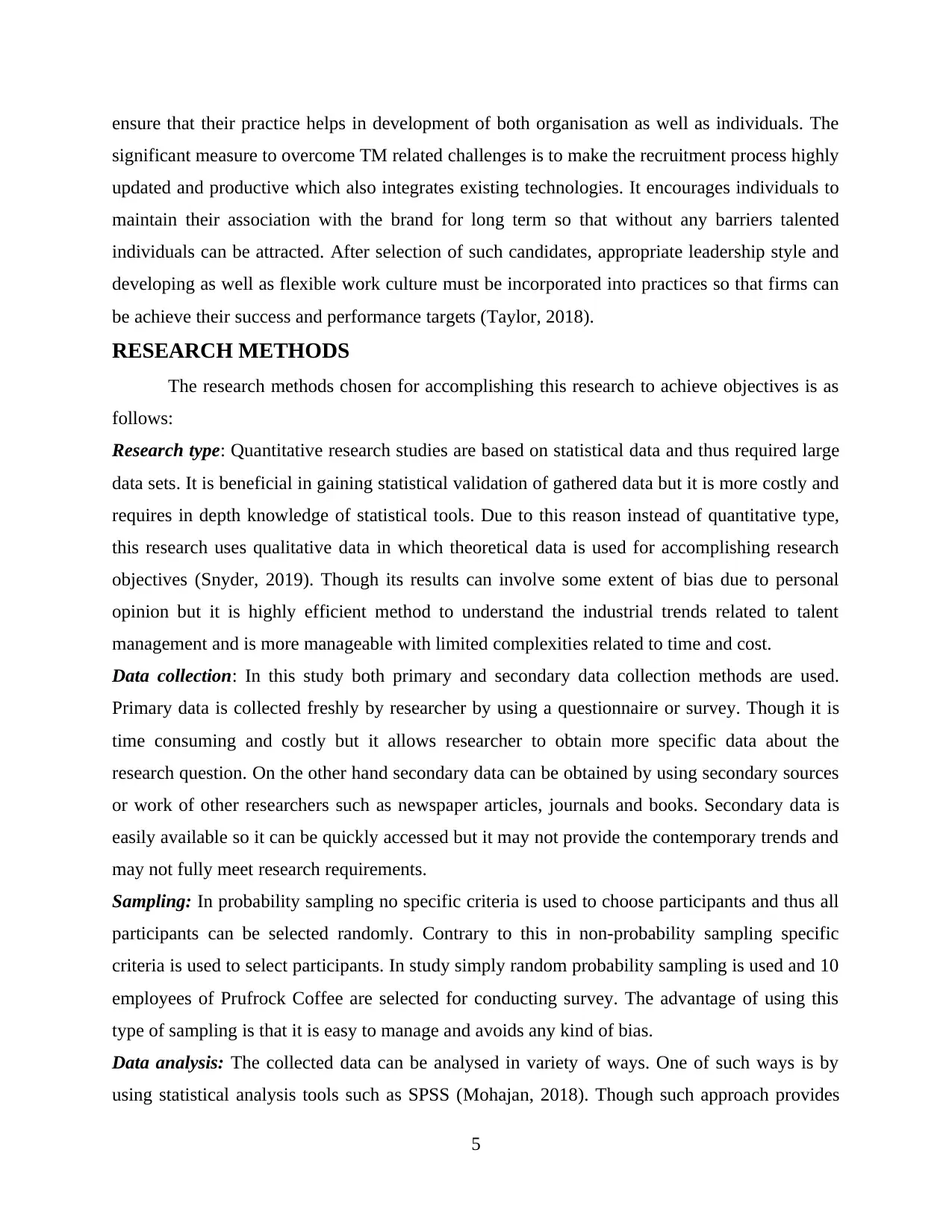
ensure that their practice helps in development of both organisation as well as individuals. The
significant measure to overcome TM related challenges is to make the recruitment process highly
updated and productive which also integrates existing technologies. It encourages individuals to
maintain their association with the brand for long term so that without any barriers talented
individuals can be attracted. After selection of such candidates, appropriate leadership style and
developing as well as flexible work culture must be incorporated into practices so that firms can
be achieve their success and performance targets (Taylor, 2018).
RESEARCH METHODS
The research methods chosen for accomplishing this research to achieve objectives is as
follows:
Research type: Quantitative research studies are based on statistical data and thus required large
data sets. It is beneficial in gaining statistical validation of gathered data but it is more costly and
requires in depth knowledge of statistical tools. Due to this reason instead of quantitative type,
this research uses qualitative data in which theoretical data is used for accomplishing research
objectives (Snyder, 2019). Though its results can involve some extent of bias due to personal
opinion but it is highly efficient method to understand the industrial trends related to talent
management and is more manageable with limited complexities related to time and cost.
Data collection: In this study both primary and secondary data collection methods are used.
Primary data is collected freshly by researcher by using a questionnaire or survey. Though it is
time consuming and costly but it allows researcher to obtain more specific data about the
research question. On the other hand secondary data can be obtained by using secondary sources
or work of other researchers such as newspaper articles, journals and books. Secondary data is
easily available so it can be quickly accessed but it may not provide the contemporary trends and
may not fully meet research requirements.
Sampling: In probability sampling no specific criteria is used to choose participants and thus all
participants can be selected randomly. Contrary to this in non-probability sampling specific
criteria is used to select participants. In study simply random probability sampling is used and 10
employees of Prufrock Coffee are selected for conducting survey. The advantage of using this
type of sampling is that it is easy to manage and avoids any kind of bias.
Data analysis: The collected data can be analysed in variety of ways. One of such ways is by
using statistical analysis tools such as SPSS (Mohajan, 2018). Though such approach provides
5
significant measure to overcome TM related challenges is to make the recruitment process highly
updated and productive which also integrates existing technologies. It encourages individuals to
maintain their association with the brand for long term so that without any barriers talented
individuals can be attracted. After selection of such candidates, appropriate leadership style and
developing as well as flexible work culture must be incorporated into practices so that firms can
be achieve their success and performance targets (Taylor, 2018).
RESEARCH METHODS
The research methods chosen for accomplishing this research to achieve objectives is as
follows:
Research type: Quantitative research studies are based on statistical data and thus required large
data sets. It is beneficial in gaining statistical validation of gathered data but it is more costly and
requires in depth knowledge of statistical tools. Due to this reason instead of quantitative type,
this research uses qualitative data in which theoretical data is used for accomplishing research
objectives (Snyder, 2019). Though its results can involve some extent of bias due to personal
opinion but it is highly efficient method to understand the industrial trends related to talent
management and is more manageable with limited complexities related to time and cost.
Data collection: In this study both primary and secondary data collection methods are used.
Primary data is collected freshly by researcher by using a questionnaire or survey. Though it is
time consuming and costly but it allows researcher to obtain more specific data about the
research question. On the other hand secondary data can be obtained by using secondary sources
or work of other researchers such as newspaper articles, journals and books. Secondary data is
easily available so it can be quickly accessed but it may not provide the contemporary trends and
may not fully meet research requirements.
Sampling: In probability sampling no specific criteria is used to choose participants and thus all
participants can be selected randomly. Contrary to this in non-probability sampling specific
criteria is used to select participants. In study simply random probability sampling is used and 10
employees of Prufrock Coffee are selected for conducting survey. The advantage of using this
type of sampling is that it is easy to manage and avoids any kind of bias.
Data analysis: The collected data can be analysed in variety of ways. One of such ways is by
using statistical analysis tools such as SPSS (Mohajan, 2018). Though such approach provides
5
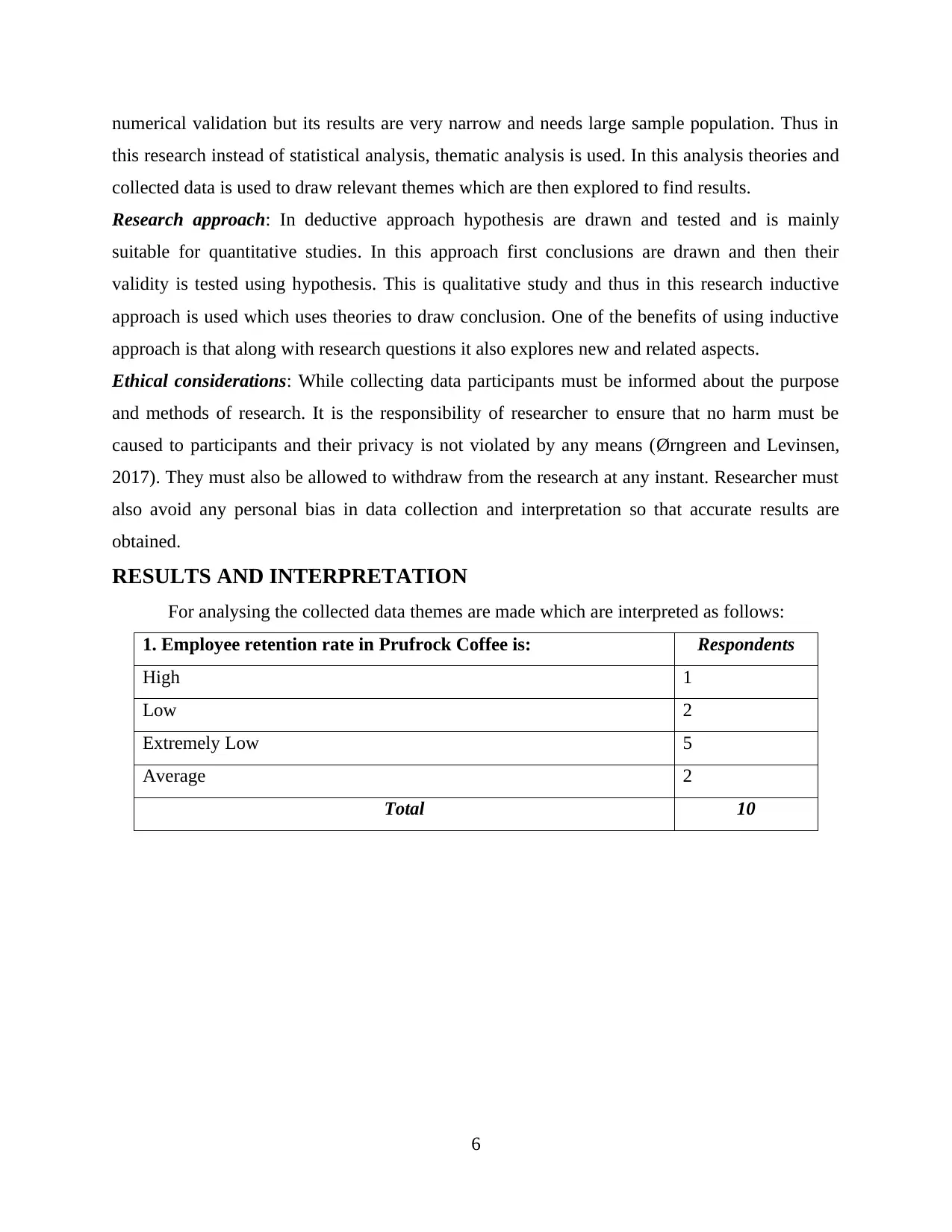
numerical validation but its results are very narrow and needs large sample population. Thus in
this research instead of statistical analysis, thematic analysis is used. In this analysis theories and
collected data is used to draw relevant themes which are then explored to find results.
Research approach: In deductive approach hypothesis are drawn and tested and is mainly
suitable for quantitative studies. In this approach first conclusions are drawn and then their
validity is tested using hypothesis. This is qualitative study and thus in this research inductive
approach is used which uses theories to draw conclusion. One of the benefits of using inductive
approach is that along with research questions it also explores new and related aspects.
Ethical considerations: While collecting data participants must be informed about the purpose
and methods of research. It is the responsibility of researcher to ensure that no harm must be
caused to participants and their privacy is not violated by any means (Ørngreen and Levinsen,
2017). They must also be allowed to withdraw from the research at any instant. Researcher must
also avoid any personal bias in data collection and interpretation so that accurate results are
obtained.
RESULTS AND INTERPRETATION
For analysing the collected data themes are made which are interpreted as follows:
1. Employee retention rate in Prufrock Coffee is: Respondents
High 1
Low 2
Extremely Low 5
Average 2
Total 10
6
this research instead of statistical analysis, thematic analysis is used. In this analysis theories and
collected data is used to draw relevant themes which are then explored to find results.
Research approach: In deductive approach hypothesis are drawn and tested and is mainly
suitable for quantitative studies. In this approach first conclusions are drawn and then their
validity is tested using hypothesis. This is qualitative study and thus in this research inductive
approach is used which uses theories to draw conclusion. One of the benefits of using inductive
approach is that along with research questions it also explores new and related aspects.
Ethical considerations: While collecting data participants must be informed about the purpose
and methods of research. It is the responsibility of researcher to ensure that no harm must be
caused to participants and their privacy is not violated by any means (Ørngreen and Levinsen,
2017). They must also be allowed to withdraw from the research at any instant. Researcher must
also avoid any personal bias in data collection and interpretation so that accurate results are
obtained.
RESULTS AND INTERPRETATION
For analysing the collected data themes are made which are interpreted as follows:
1. Employee retention rate in Prufrock Coffee is: Respondents
High 1
Low 2
Extremely Low 5
Average 2
Total 10
6
⊘ This is a preview!⊘
Do you want full access?
Subscribe today to unlock all pages.

Trusted by 1+ million students worldwide
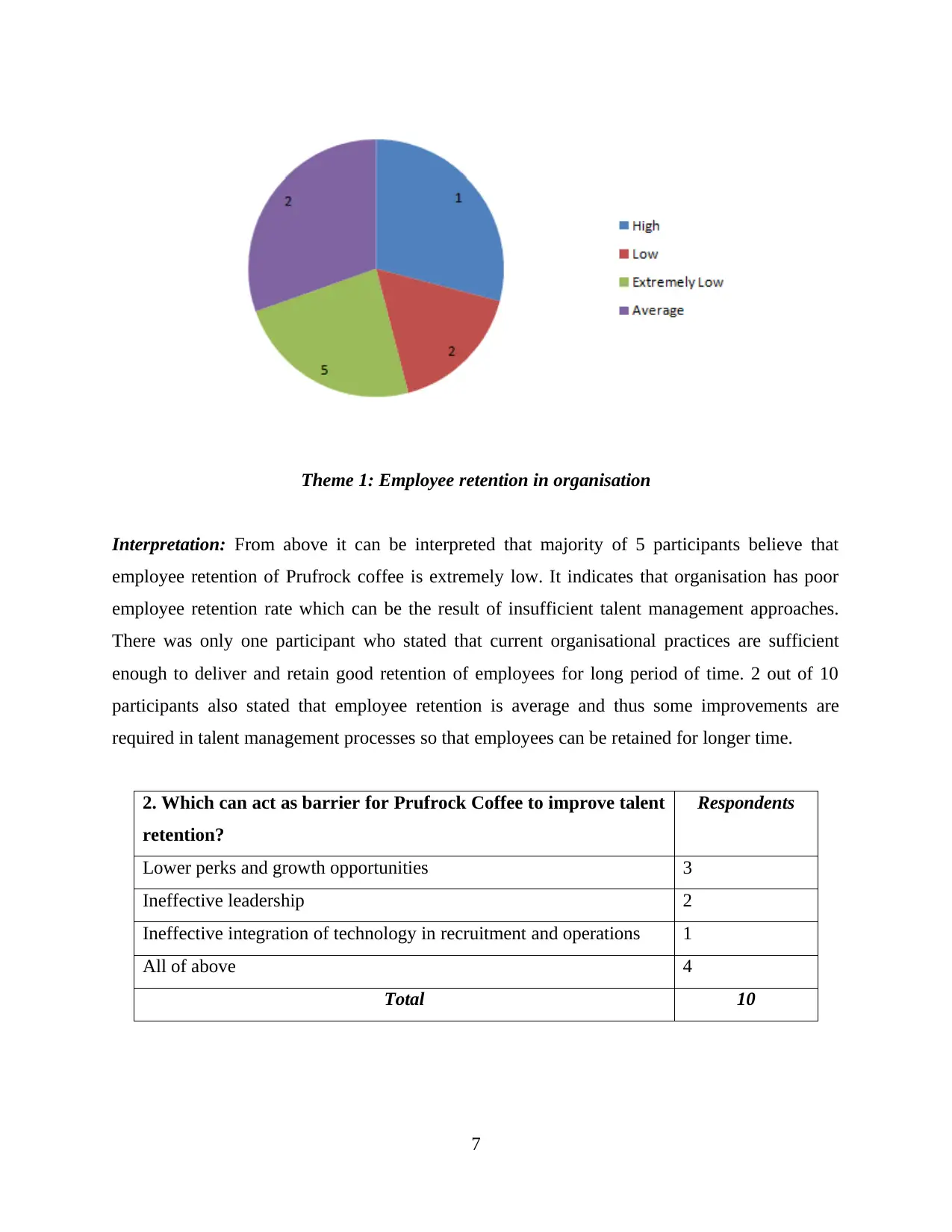
Theme 1: Employee retention in organisation
Interpretation: From above it can be interpreted that majority of 5 participants believe that
employee retention of Prufrock coffee is extremely low. It indicates that organisation has poor
employee retention rate which can be the result of insufficient talent management approaches.
There was only one participant who stated that current organisational practices are sufficient
enough to deliver and retain good retention of employees for long period of time. 2 out of 10
participants also stated that employee retention is average and thus some improvements are
required in talent management processes so that employees can be retained for longer time.
2. Which can act as barrier for Prufrock Coffee to improve talent
retention?
Respondents
Lower perks and growth opportunities 3
Ineffective leadership 2
Ineffective integration of technology in recruitment and operations 1
All of above 4
Total 10
7
Interpretation: From above it can be interpreted that majority of 5 participants believe that
employee retention of Prufrock coffee is extremely low. It indicates that organisation has poor
employee retention rate which can be the result of insufficient talent management approaches.
There was only one participant who stated that current organisational practices are sufficient
enough to deliver and retain good retention of employees for long period of time. 2 out of 10
participants also stated that employee retention is average and thus some improvements are
required in talent management processes so that employees can be retained for longer time.
2. Which can act as barrier for Prufrock Coffee to improve talent
retention?
Respondents
Lower perks and growth opportunities 3
Ineffective leadership 2
Ineffective integration of technology in recruitment and operations 1
All of above 4
Total 10
7
Paraphrase This Document
Need a fresh take? Get an instant paraphrase of this document with our AI Paraphraser
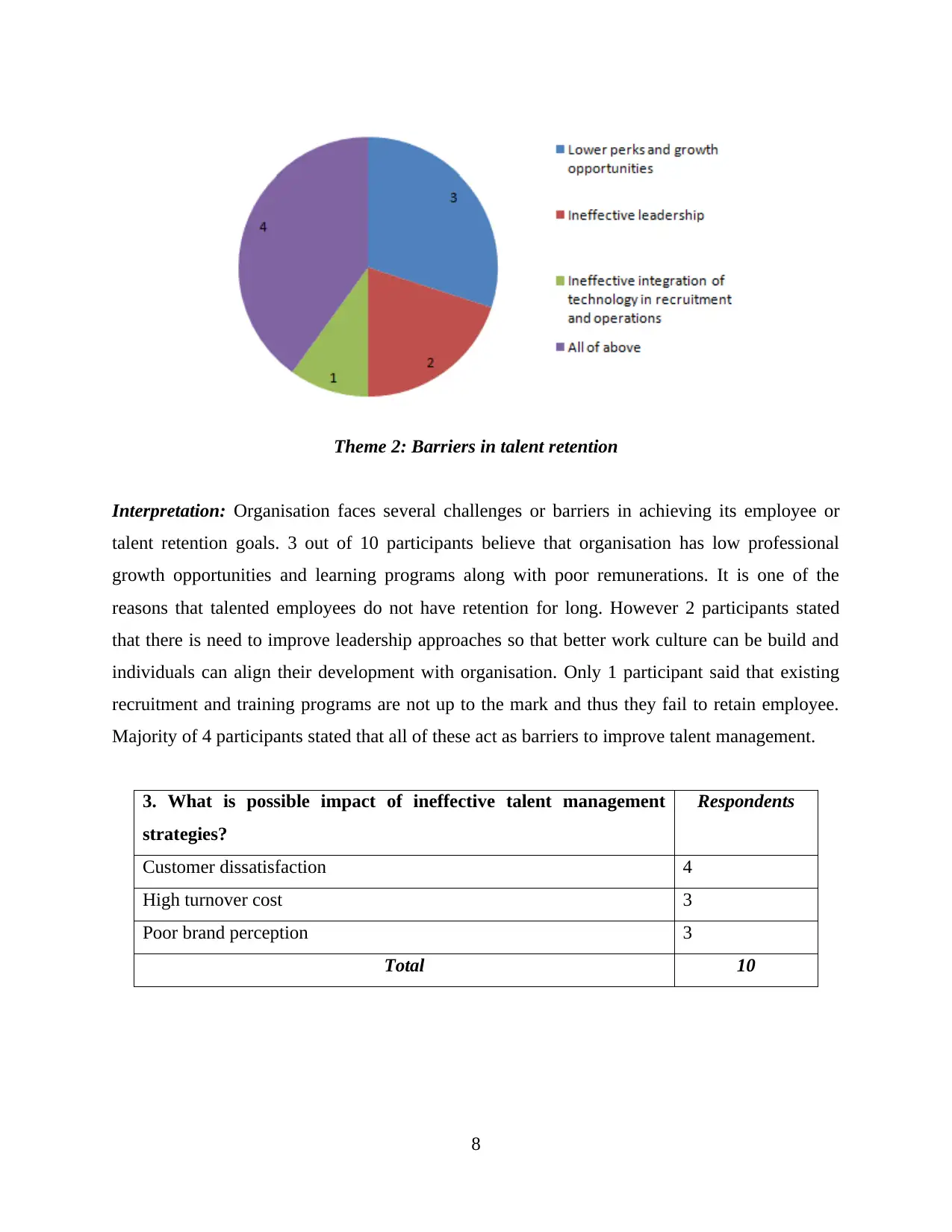
Theme 2: Barriers in talent retention
Interpretation: Organisation faces several challenges or barriers in achieving its employee or
talent retention goals. 3 out of 10 participants believe that organisation has low professional
growth opportunities and learning programs along with poor remunerations. It is one of the
reasons that talented employees do not have retention for long. However 2 participants stated
that there is need to improve leadership approaches so that better work culture can be build and
individuals can align their development with organisation. Only 1 participant said that existing
recruitment and training programs are not up to the mark and thus they fail to retain employee.
Majority of 4 participants stated that all of these act as barriers to improve talent management.
3. What is possible impact of ineffective talent management
strategies?
Respondents
Customer dissatisfaction 4
High turnover cost 3
Poor brand perception 3
Total 10
8
Interpretation: Organisation faces several challenges or barriers in achieving its employee or
talent retention goals. 3 out of 10 participants believe that organisation has low professional
growth opportunities and learning programs along with poor remunerations. It is one of the
reasons that talented employees do not have retention for long. However 2 participants stated
that there is need to improve leadership approaches so that better work culture can be build and
individuals can align their development with organisation. Only 1 participant said that existing
recruitment and training programs are not up to the mark and thus they fail to retain employee.
Majority of 4 participants stated that all of these act as barriers to improve talent management.
3. What is possible impact of ineffective talent management
strategies?
Respondents
Customer dissatisfaction 4
High turnover cost 3
Poor brand perception 3
Total 10
8
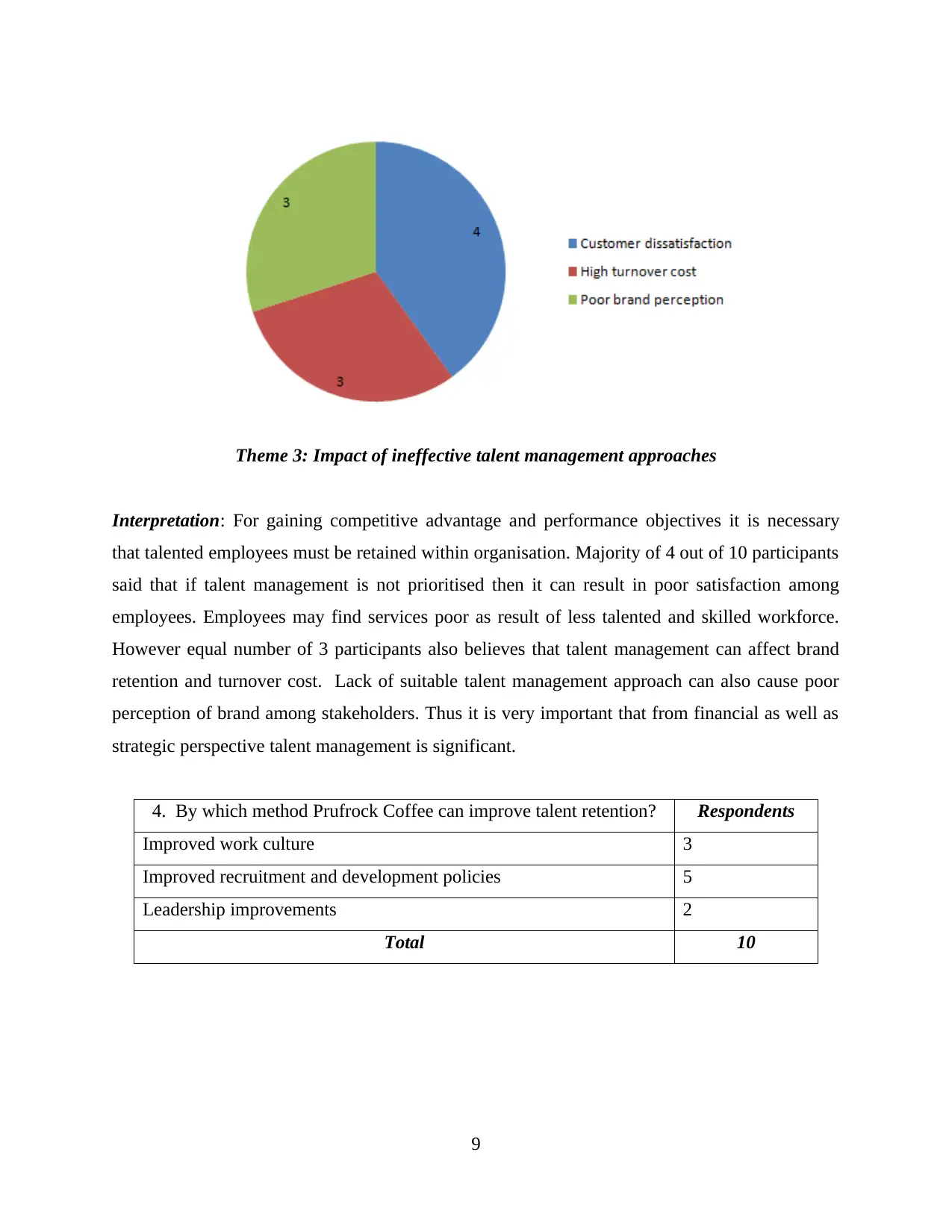
Theme 3: Impact of ineffective talent management approaches
Interpretation: For gaining competitive advantage and performance objectives it is necessary
that talented employees must be retained within organisation. Majority of 4 out of 10 participants
said that if talent management is not prioritised then it can result in poor satisfaction among
employees. Employees may find services poor as result of less talented and skilled workforce.
However equal number of 3 participants also believes that talent management can affect brand
retention and turnover cost. Lack of suitable talent management approach can also cause poor
perception of brand among stakeholders. Thus it is very important that from financial as well as
strategic perspective talent management is significant.
4. By which method Prufrock Coffee can improve talent retention? Respondents
Improved work culture 3
Improved recruitment and development policies 5
Leadership improvements 2
Total 10
9
Interpretation: For gaining competitive advantage and performance objectives it is necessary
that talented employees must be retained within organisation. Majority of 4 out of 10 participants
said that if talent management is not prioritised then it can result in poor satisfaction among
employees. Employees may find services poor as result of less talented and skilled workforce.
However equal number of 3 participants also believes that talent management can affect brand
retention and turnover cost. Lack of suitable talent management approach can also cause poor
perception of brand among stakeholders. Thus it is very important that from financial as well as
strategic perspective talent management is significant.
4. By which method Prufrock Coffee can improve talent retention? Respondents
Improved work culture 3
Improved recruitment and development policies 5
Leadership improvements 2
Total 10
9
⊘ This is a preview!⊘
Do you want full access?
Subscribe today to unlock all pages.

Trusted by 1+ million students worldwide
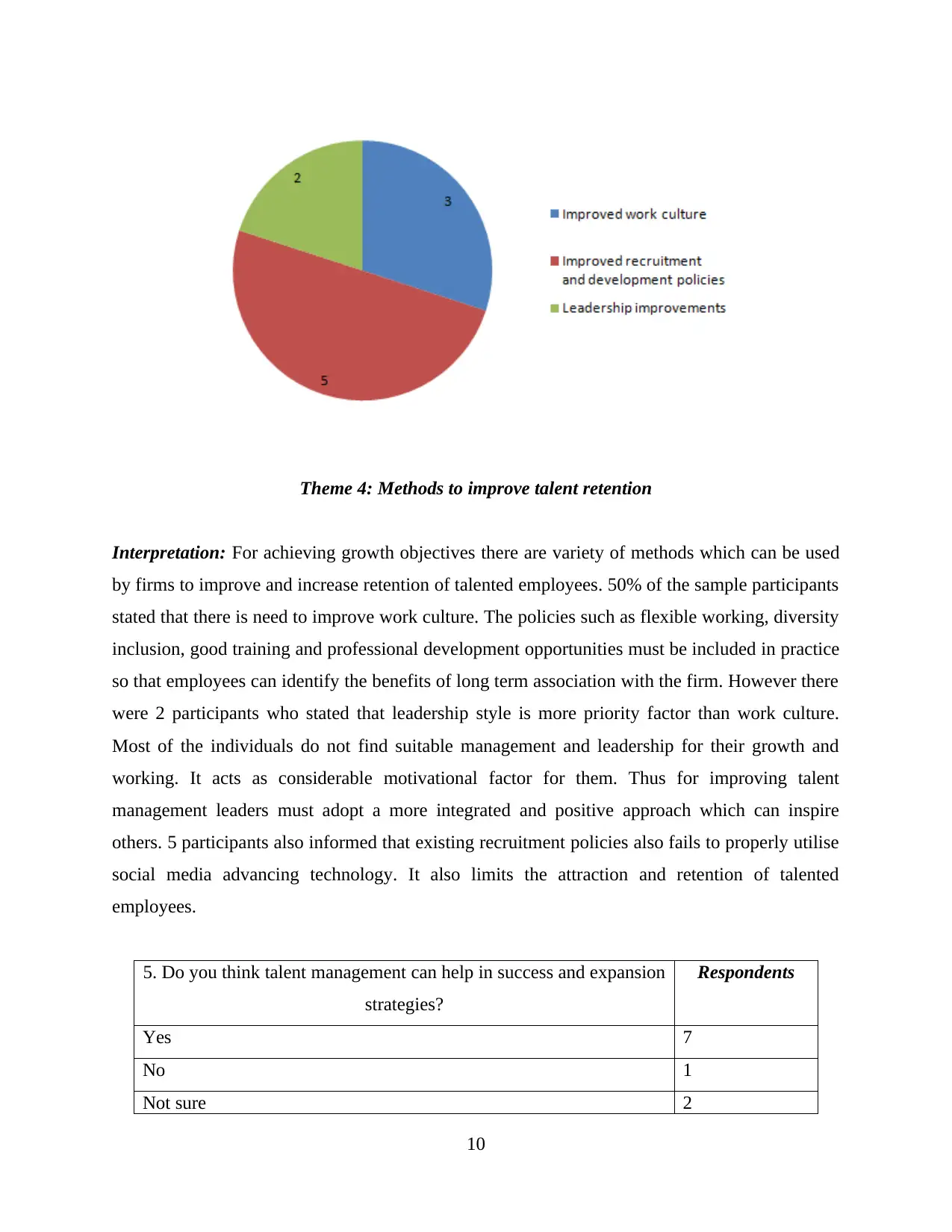
Theme 4: Methods to improve talent retention
Interpretation: For achieving growth objectives there are variety of methods which can be used
by firms to improve and increase retention of talented employees. 50% of the sample participants
stated that there is need to improve work culture. The policies such as flexible working, diversity
inclusion, good training and professional development opportunities must be included in practice
so that employees can identify the benefits of long term association with the firm. However there
were 2 participants who stated that leadership style is more priority factor than work culture.
Most of the individuals do not find suitable management and leadership for their growth and
working. It acts as considerable motivational factor for them. Thus for improving talent
management leaders must adopt a more integrated and positive approach which can inspire
others. 5 participants also informed that existing recruitment policies also fails to properly utilise
social media advancing technology. It also limits the attraction and retention of talented
employees.
5. Do you think talent management can help in success and expansion
strategies?
Respondents
Yes 7
No 1
Not sure 2
10
Interpretation: For achieving growth objectives there are variety of methods which can be used
by firms to improve and increase retention of talented employees. 50% of the sample participants
stated that there is need to improve work culture. The policies such as flexible working, diversity
inclusion, good training and professional development opportunities must be included in practice
so that employees can identify the benefits of long term association with the firm. However there
were 2 participants who stated that leadership style is more priority factor than work culture.
Most of the individuals do not find suitable management and leadership for their growth and
working. It acts as considerable motivational factor for them. Thus for improving talent
management leaders must adopt a more integrated and positive approach which can inspire
others. 5 participants also informed that existing recruitment policies also fails to properly utilise
social media advancing technology. It also limits the attraction and retention of talented
employees.
5. Do you think talent management can help in success and expansion
strategies?
Respondents
Yes 7
No 1
Not sure 2
10
Paraphrase This Document
Need a fresh take? Get an instant paraphrase of this document with our AI Paraphraser
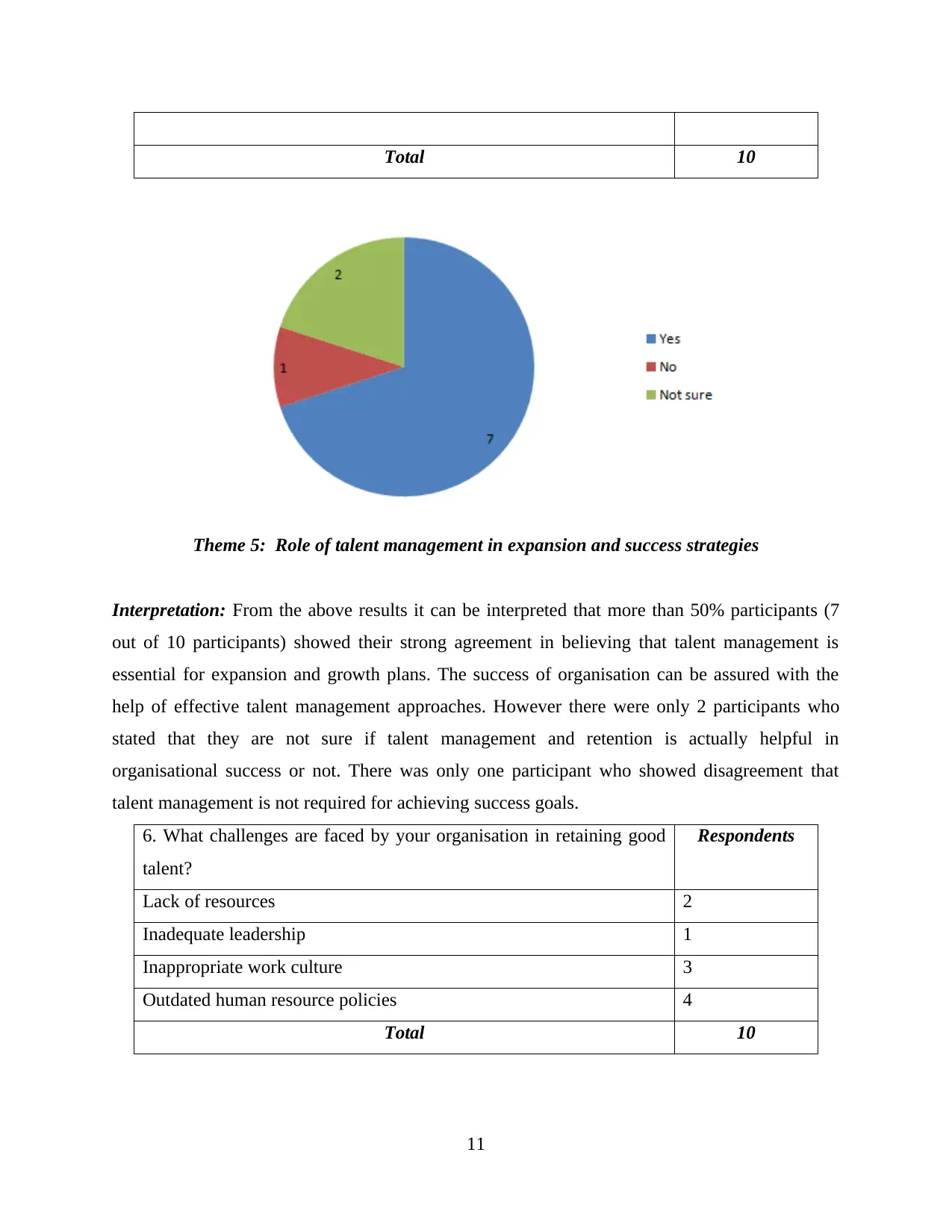
Total 10
Theme 5: Role of talent management in expansion and success strategies
Interpretation: From the above results it can be interpreted that more than 50% participants (7
out of 10 participants) showed their strong agreement in believing that talent management is
essential for expansion and growth plans. The success of organisation can be assured with the
help of effective talent management approaches. However there were only 2 participants who
stated that they are not sure if talent management and retention is actually helpful in
organisational success or not. There was only one participant who showed disagreement that
talent management is not required for achieving success goals.
6. What challenges are faced by your organisation in retaining good
talent?
Respondents
Lack of resources 2
Inadequate leadership 1
Inappropriate work culture 3
Outdated human resource policies 4
Total 10
11
Theme 5: Role of talent management in expansion and success strategies
Interpretation: From the above results it can be interpreted that more than 50% participants (7
out of 10 participants) showed their strong agreement in believing that talent management is
essential for expansion and growth plans. The success of organisation can be assured with the
help of effective talent management approaches. However there were only 2 participants who
stated that they are not sure if talent management and retention is actually helpful in
organisational success or not. There was only one participant who showed disagreement that
talent management is not required for achieving success goals.
6. What challenges are faced by your organisation in retaining good
talent?
Respondents
Lack of resources 2
Inadequate leadership 1
Inappropriate work culture 3
Outdated human resource policies 4
Total 10
11
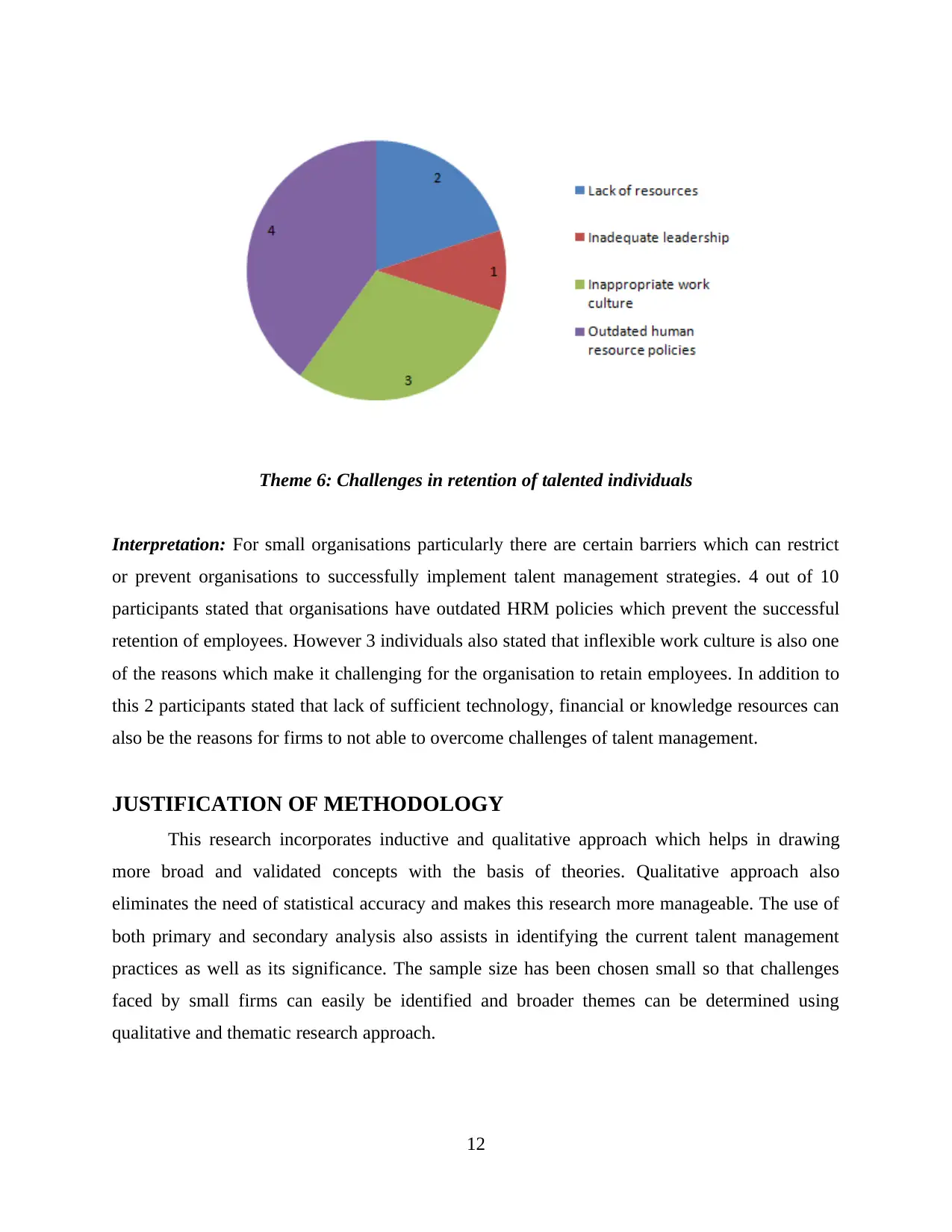
Theme 6: Challenges in retention of talented individuals
Interpretation: For small organisations particularly there are certain barriers which can restrict
or prevent organisations to successfully implement talent management strategies. 4 out of 10
participants stated that organisations have outdated HRM policies which prevent the successful
retention of employees. However 3 individuals also stated that inflexible work culture is also one
of the reasons which make it challenging for the organisation to retain employees. In addition to
this 2 participants stated that lack of sufficient technology, financial or knowledge resources can
also be the reasons for firms to not able to overcome challenges of talent management.
JUSTIFICATION OF METHODOLOGY
This research incorporates inductive and qualitative approach which helps in drawing
more broad and validated concepts with the basis of theories. Qualitative approach also
eliminates the need of statistical accuracy and makes this research more manageable. The use of
both primary and secondary analysis also assists in identifying the current talent management
practices as well as its significance. The sample size has been chosen small so that challenges
faced by small firms can easily be identified and broader themes can be determined using
qualitative and thematic research approach.
12
Interpretation: For small organisations particularly there are certain barriers which can restrict
or prevent organisations to successfully implement talent management strategies. 4 out of 10
participants stated that organisations have outdated HRM policies which prevent the successful
retention of employees. However 3 individuals also stated that inflexible work culture is also one
of the reasons which make it challenging for the organisation to retain employees. In addition to
this 2 participants stated that lack of sufficient technology, financial or knowledge resources can
also be the reasons for firms to not able to overcome challenges of talent management.
JUSTIFICATION OF METHODOLOGY
This research incorporates inductive and qualitative approach which helps in drawing
more broad and validated concepts with the basis of theories. Qualitative approach also
eliminates the need of statistical accuracy and makes this research more manageable. The use of
both primary and secondary analysis also assists in identifying the current talent management
practices as well as its significance. The sample size has been chosen small so that challenges
faced by small firms can easily be identified and broader themes can be determined using
qualitative and thematic research approach.
12
⊘ This is a preview!⊘
Do you want full access?
Subscribe today to unlock all pages.

Trusted by 1+ million students worldwide
1 out of 15
Related Documents
Your All-in-One AI-Powered Toolkit for Academic Success.
+13062052269
info@desklib.com
Available 24*7 on WhatsApp / Email
![[object Object]](/_next/static/media/star-bottom.7253800d.svg)
Unlock your academic potential
Copyright © 2020–2025 A2Z Services. All Rights Reserved. Developed and managed by ZUCOL.





